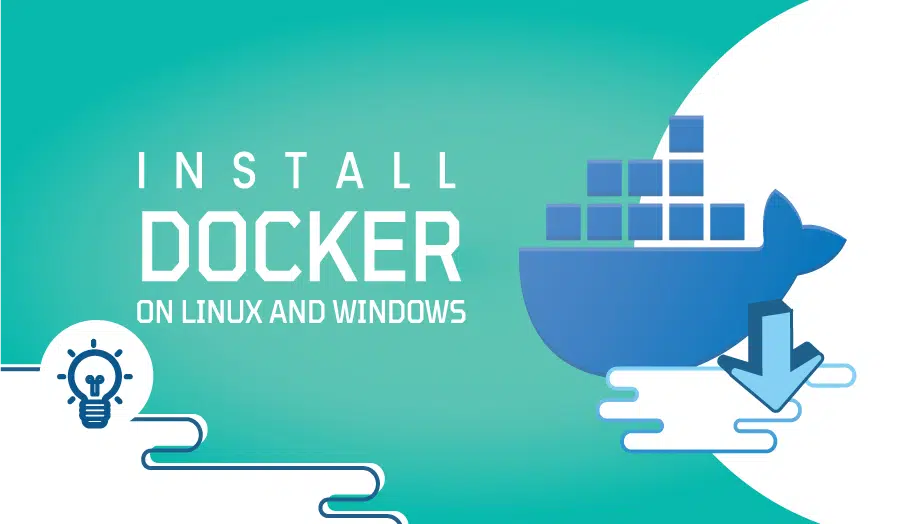Easy way to Install Docker on Linux and Windows step by step Guide
This tutorial will guide you on a way to installation the Docker on
- Ubuntu 18
- CentOS 8
- Debian 9/10
- Windows Server 2016/2019
1. Install Docker on Ubuntu 18
Prerequisites
- Ubuntu 18.04 or Ubuntu 19.10.
- sudo user.
Step 1: Update the list of packages
We start by updating the local databases. Open the command prompt and runsudo apt-get update
Step 2: Download and install dependencies
This command installs dependencies to ensure that apt command transfers files securely over https.
sudo apt install apt-transport-https ca-certificates curl software-properties-commonStep 3: Add GPG key
This is a security feature to ensure the authenticity of the installation files.
curl -fsSL https://download.docker.com/linux/ubuntu/gpg | sudo apt-key add -
Step 4: Install Docker repositories
Add the Docker repository to apt sources using the command
sudo add-apt-repository "deb [arch=amd64] https://download.docker.com/linux/ubuntu bionic stable"Step 5: Update the Repositories
Use the command below to update the repositories just added in the previous command
sudo apt-get update
You may want to confirm that you are running the installation from the Docker official repository using the command;
apt-cache policy docker-ce
Step 6: Install Docker
Use the command underneath to install the latest version of Docker.
sudo apt-get install docker-ceThe command installs the latest Docker, after which it starts the daemon and configures it to load automatically when the machine boots. Type Y and press Enter when prompted.
After it completes the manner, use the command below to confirm that the Docker installation is successful, active and running.
sudo systemctl status docker
Please note that we have used the above steps to successfully install Docker on Ubuntu 18.
2. Install Docker on CentOS 8
Prerequisites
- CentOS 8
- Sudo account
Step 1: Update Package Database
sudo yum updateType Y for yes if prompted to download package updates.
Step 2: Add and enable official Docker Repository
sudo dnf config-manager --add-repo=https://download.docker.com/linux/centos/docker-ce.repo
Step 3: Install stable version of the container.id package
The CentOS 8 does not work with some versions of container.id and gives errors when installing with the default package.
There are two ways of overcoming this challenge:
1. Deploy Docker while skipping unstable dependencies.
2. Manually upload the solid model of supported dependencies package.
Option 1: Deploy Docker while skipping unstable dependencies
Option 1 is to install Docker while automatically skipping packages that have broken dependencies and using the versions that meet certain specifications.
To do this we will use the –nobest command
sudo dnf install docker-ce --nobestThe system will scan the packages and dependencies and give you a list of what it will install. It will also show the packages it will skip due to broken dependencies.
Type Y when prompted.
This will skip the latest unstable package and use a previous stable version.
Option 2: Manually upload the solid model of supported dependencies package.
This method allows you to install the latest Docker but requires adding the stable container.id package manually.
To add the stable container.id, run
sudo dnf install https://download.docker.com/linux/centos/7/x86_64/stable/Packages/containerd.io-1.2.10-3.2.el7.x86_64.rpmInstall latest Docker Version on CentOS 8
Once the container.id is in place, you can now install Docker with the following command.
sudo dnf install docker-ce -y
Step 4: Enable and start Docker
You will now enable and start Docker using the command.
sudo systemctl enable --now dockerTo confirm that Docker is active and running use,
systemctl status docker3. Install Docker on Debian 9 and 10
Prerequisites
- Debian 9 or 10
- sudo user
Step 1: Update the installed packages
Our first step is to update the list of packages installed on Debian.
sudo apt update
Step 2: Install security package to enforce https
We will now install the files required to ensure that the apt will only use the https connections to transfer files to and from other computers
sudo apt install apt-transport-https ca-certificates curl gnupg2 software-properties-common
Step 3: Install GPG key to validate downloads
The GPG key ensures that we only obtain authentic files from the repository. To add the key, run the command below. This will return an OK.
curl -fsSL https://download.docker.com/linux/debian/gpg | sudo apt-key add –
Step 4: Add Docker repository to APT sources
sudo add-apt-repository "deb [arch=amd64] https://download.docker.com/linux/debian $(lsb_release -cs) stable"
Step 5: Update the list of packages
Add the just installed Docker packages to the packages database using the following command.
sudo apt update
Step 6: Install Docker on Debian
To install Docker now, run;
sudo apt install docker-ceType Y and press enter to continue with the installation when prompted to do so.
The above command will install the Docker on Debian after which it configures its engine to start on boot.
Use the command below to check the status and find out if the installation was successful.
sudo systemctl status docker4. Install Docker on Windows 2016 and 2019
The Windows Server 2016 requires the Docker enterprise edition. The instructions below will also work on Windows Server 2019.
Prerequisites
- Windows Server 2016 (64bit).
- A user account with administrator rights.
Step 1: Install the Docker PowerShell module
Once you log in as an administrator, you will get a Windows command prompt PS C:UsersAdministrator>
At the prompt, type the following command
install-module -name DockerMsftProvider –Force
The command will appear as;
PS C:UsersAdministrator> install-module -name DockerMsftProvider -ForceThis will return the following output with a prompt to type Y or N.
Type Y to proceed to install and import the NuGet provider. The computer will go back to the command prompt after a short time.
Step 2: Install Docker
Type the following command at the prompt.
PS C:UsersAdministrator>Install-Package Docker –Providername DockerMsftProvider -ForceThe command will install the Docker package. If successful, you will see a warning message that requests you to restart the computer.
Step 3: Restart the computer and verify Docker is installed
Type the Restart-Computer command at the prompt.
PS C:UsersAdministrator>Restart-Computer
Once the computer restarts, use the following command to verify,
1. that Docker is installed successfully.
2. its version.
PS C:UsersAdministrator>docker version






















